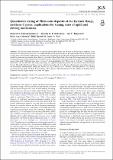Quantitative dating of pleistocene deposits of the Kyrenia range, Northern Cyprus : implications for timing, rates of uplift and driving mechanisms
Abstract
The Kyrenia Range underwent tectonically driven uplift during the Pliocene to Pleistocene in response to the interaction of various tectonic processes. To understand the tectonic processes driving the uplift and how this is related to uplift of other areas of the Eastern Mediterranean, uranium-series disequilibrium and optically stimulated luminescence dating were applied to marine and non-marine terrace deposits exposed on the northern flank of the range. Palaeomagnetism and strontium isotope dating were used in conjunction to date the final stages of the marine environment adjacent to the Kyrenia Range prior to major surface uplift. Uplift rates range from >1.2 mm a−1, inferred during the Early Pleistocene, to <0.2 mm a−1during the Late Pleistocene. The new data show that the Kyrenia Range was uplifted contemporaneously with the Troodos Massif in southern Cyprus. The uplift of the Kyrenia Range appears to have been significantly faster than that affecting other comparable regions in the easternmost Mediterranean during the Pleistocene (e.g. Lebanon coast; southern Anatolian plateau). The driving mechanism for the uplift of both the Kyrenia Range and the Troodos Massif is inferred to be the collision of the Eratosthenes Seamount with the Cyprus trench to the south of Cyprus.
Citation
Palamakumbura , R N , Robertson , A H F , Kinnaird , T C , van Calsteren , P , Kroon , D & Tait , J A 2016 , ' Quantitative dating of pleistocene deposits of the Kyrenia range, Northern Cyprus : implications for timing, rates of uplift and driving mechanisms ' , Journal of the Geological Society , vol. 173 , no. 6 , pp. 933-948 . https://doi.org/10.1144/jgs2015-130
Publication
Journal of the Geological Society
Status
Peer reviewed
ISSN
0016-7649Type
Journal article
Description
R.N.P. acknowledges the NERC CASE scholarship at the University of Edinburgh. Additional field and laboratory work was aided by the DARIUS Programme to A.H.F.R. and T.C.K. We are grateful for the additional financial support provided by the John Dixon Memorial Fund.Collections
Items in the St Andrews Research Repository are protected by copyright, with all rights reserved, unless otherwise indicated.

